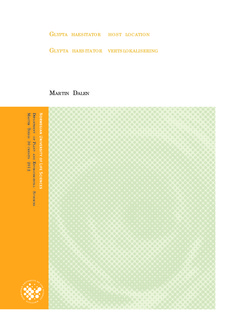| dc.contributor.author | Dalen, Martin | |
| dc.date.accessioned | 2013-03-26T15:51:31Z | |
| dc.date.available | 2013-03-26T15:51:31Z | |
| dc.date.copyright | 2012 | |
| dc.date.issued | 2013-03-26 | |
| dc.identifier.uri | http://hdl.handle.net/11250/189573 | |
| dc.description.abstract | Snyltevepsen Glypta haesitator parasiterer erteviklerlarver (Cydia nigricana). Formålet med dette studiet var å identifisere luktkilder som tiltrekker seg naive G. haesitator hunner på søken etter et område å legge egg. Adferdsanalyser i vindtunnel viste at naive G. haesitator hunner er tiltrukket av erteviklerens matplante, voksne ertevikleres skall og erteviklerlarvens avføring. Infiserte erteplanter uten belger tiltrakk seg ikke naive G. haesitator hunner, hvilket indikerer at luktstoffer fra bakgrunnen er viktig for G. haesitator vertslokalisering.
Flyktige stoffer avgitt av erteplanter, skall fra voksne erteviklere og erteviklerlarvens avføring ble prøvetatt med SPME-fiber eller headspace oppsamling. Prøveanalyser med gasskromatograf koblet til massespektrometer indikerte at de flyktige stoffene avgitt fra erteplantene, larve-avføringen og erteviklerskallene er vanlig å avgi for planter i mange ulike slekter. Det betyr at G. haesitator sannsynligvis bruker ratiospesifikk luktgjenkjennelse. Mer forskning er nødvendig for å fastslå om erteviklere og G. haesitator er tiltrukket av like stoffer i lik ratio.
I dette studiet parasiterte G. haesitator 22% av innsamlede, overvintrede erteviklerkokonger fra en erteåker. Totalt var 70% av kokongene parasitert av tilsammen tre ulike arter. Fordi erte-vikleren og G. haesitator begge tiltrekkes av erteplanter, kan bruk av semiokjemikalier fra erteplanten til bruk i erteviklerbekjempelse redusere G. haesitators parasitering. En slik uønsket effekt vil trolig hindre bruk av semiokjemikalier til bekjempelse av skadedyr. Effekten flyktige, organiske stoffer har på parasitering bør derfor vurderes før stoffene implementeres i skadedyr-bekjempelse.
Glypta haesitator is a larval parasitoid of the pea moth (Cydia nigricana). The objective of this study was to identify semiochemical sources exploited by naive, female G. haesitator looking for an oviposition site. In a wind tunnel bioassay G. haesitator showed attraction to pea moth larval frass, pea moth scales and pea moth host plants. Infected pea plants without pods did not elicit G. haesitator attraction, indicating that the background odour is important for G. haesitator host location.
Volatile compounds emitted from pea moth larval frass, pea moth scales and pea plants were sampled by SPME-fibre or headspace collection. Gas-chromatograph coupled with mass spectrometer analyses of the volatiles indicated presence of compounds commonly emitted by plants in many genera. The results indicate that G. haesitator use ratio-specific odour recognition. Further research is needed to investigate if pea moths and G. haesitator are attracted to similar compounds in similar ratio.
G. haesitator parasitizised 22% of the collected overwintered pea moth cocoons from a pea field. The combined parasitization rate by three parasitoids was 70%. Because both the pea moth and G. haesitator are attracted to pea plants, the use of semiochemicals from the pea plant in pea moth pest management could reduce G. haesitator parasitization rate. Such adverse effects are likely to hamper the utilization of semiochemicals in pest management. The impact of a volatile organic compound on parasitization should therefore be considered prior to its implementation in pest management. | no_NO |
| dc.description.sponsorship | YARA Norge AS | no_NO |
| dc.language.iso | eng | no_NO |
| dc.publisher | Norwegian University of Life Sciences, Ås | |
| dc.subject | parasitization | no_NO |
| dc.subject | semiochemicals | no_NO |
| dc.subject | parasitering | no_NO |
| dc.subject | semiokjemikalier | no_NO |
| dc.title | Glypta haesitator host location | no_NO |
| dc.title.alternative | Glypta haesitator vertslokalisering | no_NO |
| dc.type | Master thesis | no_NO |
| dc.subject.nsi | VDP::Mathematics and natural science: 400::Zoology and botany: 480::Parasitology: 484 | no_NO |
| dc.subject.nsi | VDP::Agriculture and fishery disciplines: 900::Agriculture disciplines: 910::Plant breeding, horticulture, plant protection, plant pathology: 911 | no_NO |
| dc.source.pagenumber | 40 | no_NO |
